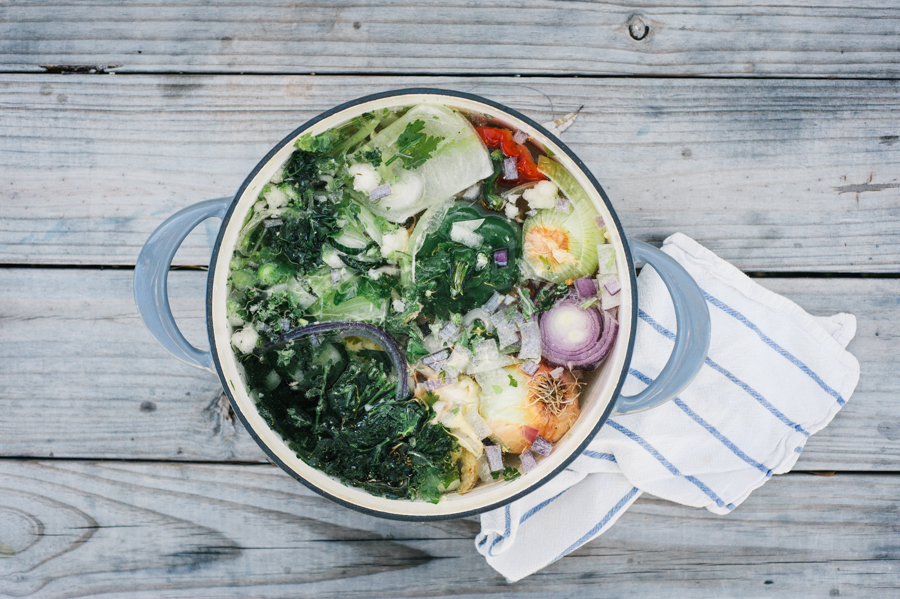
Last year, I read Tamar Adler’s An Everlasting Meal for the first time. Subtitled Cooking with Grace and Economy, it was those final words that allured me most. Grace. Economy. Those two words have at times felt at odds with one another in our family kitchen and budget, as cooking feels neither intuitive nor economical for me, when done with quality.
Over the course of the year, I have referenced this book hundreds of times in my cooking. It is not a recipe book, although she does include a few, or an easy quick-guide to understanding food. It will not persuade you to adhere to a specific diet or to ostracize any one food group. Rather it is an instruction manual for those who find the kitchen awkward or inconsistent, and it is best to read it in the way you boil water: with simplicity and patience. The lessons, although read at once, have settled slowly into personal practice. I opt to try one new idea or skill at a time before moving on to another. That said, it is by far the most influential book I have yet read about making food, and it is always found either on my nightstand or kitchen counter splotched with food stains and penned markings. To put in perspective: if anyone ever wanted to borrow my copy, I would purchase a personal copy for them instead.

Making homemade broth from veggie scraps was the first lesson I learned from Adler. Broth is a staple in our home, especially in the colder months, used for everything from hearty stews to broth soups to making rice or nursing our immune system. A major premise in the book is that one meal should always fold into another, repurposing the scraps from one dinner into something else altogether. Although I had been making my own broth before this, I had always used fresh vegetables, purchased specifically for the purpose of diffusing their nutrients into water for broth and later disposing. While on one hand, this created a high-quality broth, it was not necessarily an economical one.
Here is my new process for a simple broth, one I highly recommend for your own home during the winter season.
- Wash all parts of the veggie before any meal preparation, this way you can throw in a few peelings and such without worry of contamination. This is a great job for little helpers.
- After any meal preparation with veggies, scoop the remaining veggie choppings or good ends into a container and store in the freezer.
- When roasting chicken or beef, throw the bones immediately into a pot after you’ve cleared the meat from it.
- Smother the bones with part or all of the freezer veggies (at least 2 cups of veggies) and then top with cold water. I usually add a bit of salt and fresh garlic (mostly because I love both).
- Heat the pot to a low boil and leave it simmering for 3-6 hours, depending on the time of day and how intense you want the flavor in the broth.
- When it’s finished simmering, allow it to cool. Pour it into a freezer bag or storage container.
Overtime, I’ve learned to pay closer attention to the sort of veggies I’m gathering, too. Some veggies and herbs are stronger than others, so those batches might be used in a heartier stew or lentil soup. For instance, this particular batch has peppers and a little cilantro and zucchini, making it a tasty base for a black bean soup. I’ll make a little note on the storage bag before placing it in the freezer. This simple practice is easy to teach my children, too. Without much effort or thought, they are learning beginning lessons in economy and quality as it pertains to their food. I hope it helps simplify some practices within your own kitchen, too.



Comments
I have thoroughly enjoyed your blog and Instagram posts. Thank you putting such care and love into your writing– it is an art.
I ordered the book, I cannot wait to get it and read it. I already practice frugal cooking and homemaking in some ways but always want to learn more! Tonight I am making my first vegetable broth with scrapes similar to yours. Peppers onions cilantro and celery mostly. It smells comforting and yum so far. Excited and grateful for this new practice.
I appreciate you a lot ?
Katherine, what a gift to read this! Thank you. I think you’ll be amazed how quickly veggie scraps will add up, and also how many enriching, little lessons you’ll discover in your new book. I hope it is a treasure for you and your home. xo
Broth is our favorite too. Making it makes me feel so homey. It is such a cozy process.
I agree entirely, Raimie. A simmering pot on the stove subconsciously communicates to me that our home is well-cared for. It is cozy and comforting for all the senses. On another note, I look forward to meeting you in May. x
I read Adler’s book many years ago and enjoyed it. Thank you for reminding me of the book and how it inspired you. My husband is intuitive in the kitchen and I am in the process of becoming more comfortable being in the kitchen.
How lovely that your husband feels so comfortable with food prep. Although my own will help, I think he’s most overwhelmed by having to carry out more than one task at once. It can be tricky. As for the book, it’s a treasure, and I think you’ll find whenever you pick it up again, you’ll find something new that will meet you just where you are in your cooking life. x
Firstly, I love your words, Bethany, and the way you speak your heart. This idea of being economical in the kitchen is so practical and beneficial, along with a wonderful example to our children. I will be grabbing a copy of this book as soon as possible, and it sounds like there will be much wisdom and treasures found within the pages. Thank you for sharing! xo
Anna, thank you for you kind encouragement, and I agree with you about setting the tone for our children when it comes to food. I think you’ll love the book, as it’s filled with layers upon layers of insightful ideas to simplify cooking. I hope you enjoy. x
Bethany, thank you. This is so interesting to me and such a practical and simple approach to using scraps that I already save. Thank you
You’re welcome, Betsy. This has been one of the smallest changes with such a big impact. Saving the veggie scraps is the hardest beginning, so I’d say you’re most of the way there. Much love.
What a beautiful idea. Thank you for sharing c
I’m so glad to hear it, Claire. Keep warm. x
so loved seeing this! an everlasting meal changed so much about the way i approach cooking – making it feel easier, more joyful, more fluid. less static. working this year on using a little more up in my kitchen & finding recipes for odds and ends. cheers to economy and grace this year!
Every time I pick up her book, I discover a new nugget, something I haven’t read before or somehow missed. You’re exactly right. She has an innate language about food and cooking it that I adore. I hope it continues to trickle into our home and kitchen more and more. And yes, cheers to grace and economy! x